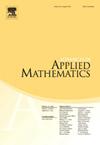Chordal matroids arising from generalized parallel connections II
IF 1.3
3区 数学
Q3 MATHEMATICS, APPLIED
引用次数: 0
Abstract
In 1961, Dirac showed that chordal graphs are exactly the graphs that can be constructed from complete graphs by a sequence of clique-sums. In an earlier paper, by analogy with Dirac's result, we introduced the class of -chordal matroids as those matroids that can be constructed from projective geometries over by a sequence of generalized parallel connections across projective geometries over . Our main result showed that when , such matroids have no induced minor in . In this paper, we show that the class of -chordal matroids coincides with the class of binary matroids that have none of , , or for as a flat. We also show that -chordal matroids can be characterized by an analogous result to Rose's 1970 characterization of chordal graphs as those that have a perfect elimination ordering of vertices.
由广义平行连接产生的弦拟阵2
1961年,狄拉克证明了弦图正是可以由一串团和从完全图构造出来的图。在之前的一篇文章中,我们类比Dirac的结果,引入了GF(q)-弦拟阵类,这些拟阵可以由GF(q)上的射影几何通过一系列跨越GF(q)上的射影几何的广义平行连接构造而成。我们的主要结果表明,当q=2时,这些拟阵在{M(C4),M(K4)}中没有诱导子。在本文中,我们证明了GF(2)-弦拟阵类与平面上n≥4时不存在M(K4)、M _ (K3,3)或M(Cn)的二元拟阵类重合。我们还证明GF(q)-弦拟阵可以用与Rose 1970年对弦图的描述类似的结果来表征,即具有顶点的完美消去顺序。
本文章由计算机程序翻译,如有差异,请以英文原文为准。
求助全文
约1分钟内获得全文
求助全文
来源期刊

Advances in Applied Mathematics
数学-应用数学
CiteScore
2.00
自引率
9.10%
发文量
88
审稿时长
85 days
期刊介绍:
Interdisciplinary in its coverage, Advances in Applied Mathematics is dedicated to the publication of original and survey articles on rigorous methods and results in applied mathematics. The journal features articles on discrete mathematics, discrete probability theory, theoretical statistics, mathematical biology and bioinformatics, applied commutative algebra and algebraic geometry, convexity theory, experimental mathematics, theoretical computer science, and other areas.
Emphasizing papers that represent a substantial mathematical advance in their field, the journal is an excellent source of current information for mathematicians, computer scientists, applied mathematicians, physicists, statisticians, and biologists. Over the past ten years, Advances in Applied Mathematics has published research papers written by many of the foremost mathematicians of our time.
 求助内容:
求助内容: 应助结果提醒方式:
应助结果提醒方式:


